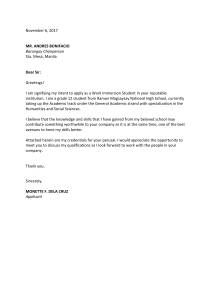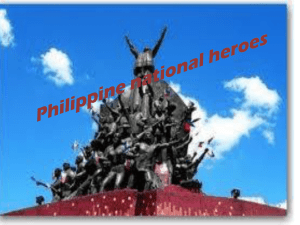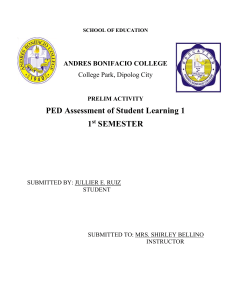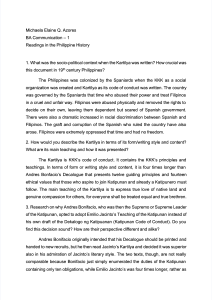Bonifacio: First President of the Philippines? A Position Paper
advertisement
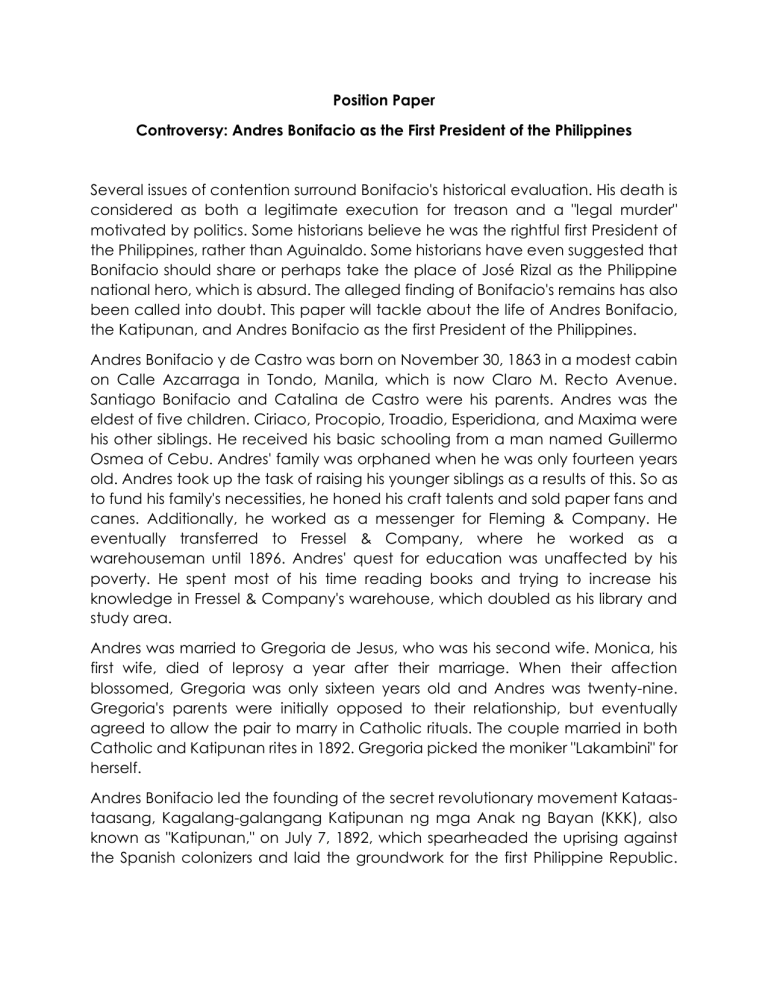
Position Paper Controversy: Andres Bonifacio as the First President of the Philippines Several issues of contention surround Bonifacio's historical evaluation. His death is considered as both a legitimate execution for treason and a "legal murder" motivated by politics. Some historians believe he was the rightful first President of the Philippines, rather than Aguinaldo. Some historians have even suggested that Bonifacio should share or perhaps take the place of José Rizal as the Philippine national hero, which is absurd. The alleged finding of Bonifacio's remains has also been called into doubt. This paper will tackle about the life of Andres Bonifacio, the Katipunan, and Andres Bonifacio as the first President of the Philippines. Andres Bonifacio y de Castro was born on November 30, 1863 in a modest cabin on Calle Azcarraga in Tondo, Manila, which is now Claro M. Recto Avenue. Santiago Bonifacio and Catalina de Castro were his parents. Andres was the eldest of five children. Ciriaco, Procopio, Troadio, Esperidiona, and Maxima were his other siblings. He received his basic schooling from a man named Guillermo Osmea of Cebu. Andres' family was orphaned when he was only fourteen years old. Andres took up the task of raising his younger siblings as a results of this. So as to fund his family's necessities, he honed his craft talents and sold paper fans and canes. Additionally, he worked as a messenger for Fleming & Company. He eventually transferred to Fressel & Company, where he worked as a warehouseman until 1896. Andres' quest for education was unaffected by his poverty. He spent most of his time reading books and trying to increase his knowledge in Fressel & Company's warehouse, which doubled as his library and study area. Andres was married to Gregoria de Jesus, who was his second wife. Monica, his first wife, died of leprosy a year after their marriage. When their affection blossomed, Gregoria was only sixteen years old and Andres was twenty-nine. Gregoria's parents were initially opposed to their relationship, but eventually agreed to allow the pair to marry in Catholic rituals. The couple married in both Catholic and Katipunan rites in 1892. Gregoria picked the moniker "Lakambini" for herself. Andres Bonifacio led the founding of the secret revolutionary movement Kataastaasang, Kagalang-galangang Katipunan ng mga Anak ng Bayan (KKK), also known as "Katipunan," on July 7, 1892, which spearheaded the uprising against the Spanish colonizers and laid the groundwork for the first Philippine Republic. Bonifacio rose through the ranks of the Katipunan to become the Supreme Leader, or "Supremo", in 1895. Katipunan was undoubtedly the most important grouped formed in the Philippine history. The only organization that envisioned a unified Filipino nation revolting against the Spaniards in order to achieve absolute independence from Spain. And Katipunan specialist and historians Dr. Milagros Guerrero, Ramon Villegas, Michael Charleston Chua and Emmanuel Encarnacion advocated for Andres Bonifacio to be acknowledged as the first president of the Philippines rather than Emilio Aguinaldo, the legally recognized one, which is again ludricrous. This viewpoint emphasizes that Andres Bonifacio was not only the leader of the Katipunan as a revolutionary secret society, as traditional historiography has emphasized, but that he also established and led a revolutionary government through the Katipunan from 1896 to 1897, prior to the formation of a revolutionary government led by Emilio Aguinaldo at the Tejeros Convention. According to Guerrero, Bonifacio had a notion of the Philippine country known as Haring Bayang Katagalugan, which was supplanted by Aguinaldo’s concept of Filipinas. This claims was supported by this two important documents that would probed the presidency of Andres Bonifacio. First, the appointment paper of Emilio Jacinto as lead general of forces North of Manila signed by Andres Bonifacio on 15 April 1897, with a letterhead that declared: “M. Andres Bonifacio (Maypagasa), Pańgulo nang Haring Bayang Katagalugan, Maytayo nang K. K. Katipunan nang mańga Anak nang Bayan at Unang Nag Galaw nang Panghihimagsik,” Second, a printed engraving of Bonifacio from the 8 of February 1897 edition form La Ilustración Española y Americana, a Madrid-based daily, with a caption that says: “Andrés Bonifacio, titulado «presidente» de la Republica Tagala.” In my perspective, the materials shown above are self-proclaimed. Moreover, they are just inventing the fact that Andres Bonifacio is the Philippines’ first president. The reason for this is that Andres Bonifacio’s administration was not a government since it lacked the essential elements of a recognized government of the West. If Bonifacio was elected president because he was Supremo of the Katipunan, he should have been the third president. And Deodato Arellano, the Katipunan’s founder, was the first president (1892-1893), while Roman Basa was the second (1893-1895). Yes, Andres Bonifacio did announce the Katipunan revolutionary movement, but it was exclusively restricted to the 'Tagalog' provinces — the Central Luzon provinces that surround Manila, such as Bulacan, Morong, Cavite, Tayabas, Batangas, Nueva Ecija, and Pampanga. In actuality, he established a government confined to the Tagalogs of Luzon, which he termed Haring Bayang Katalugan, or the Sovereign Tagalog Nation. However, his revolution is limited to the Tagalog regions rather than the entire country. So, I do not agree on Andres Bonifacio as the Philippines' first president. To refer to him as such is akin to referring to Francisco Dagohoy of Bohol as the Philippines' first president. Some historians sensationalized it since Bonifacio's revolt occurred near Manila, the administrative and commercial hub of the whole archipelago. Furthermore, if Katipunan is the Philippines' first government before the First Philippine Republic, Andres Bonifacio is not the Katipunan's first supremo. Deodato Arellano, another La Liga Filipina and Karipunan founder, was the first chosen Supremo. So, in any case, Andres Bonifacio would be mentioned as a former president, but not as the first. I do not think of him as the first president of the Philippines but rather I think of him as the leader of Katipunan. However, this controversy does not diminish his contributions to us Filipinos and to the Philippine history.
